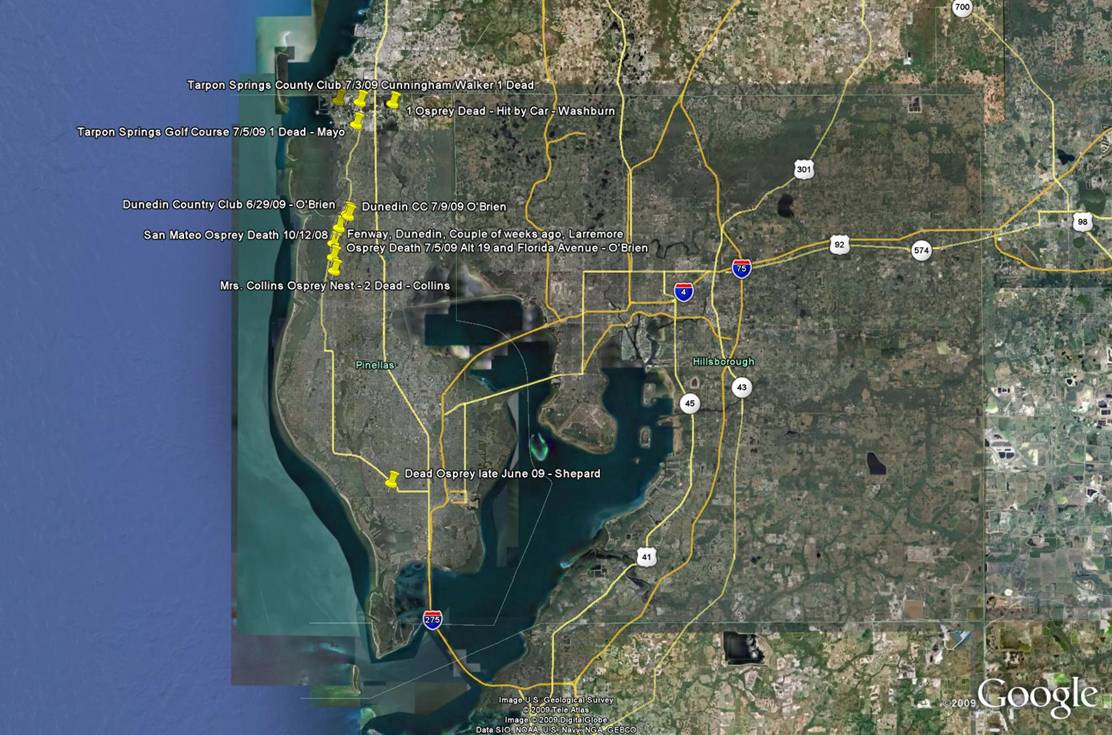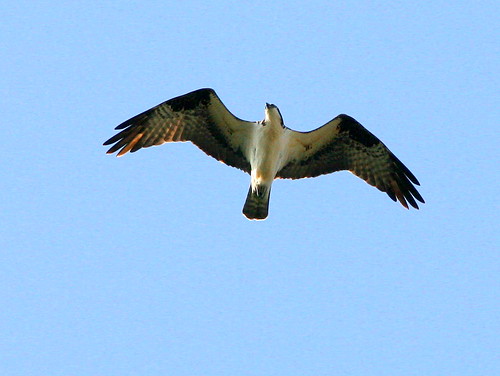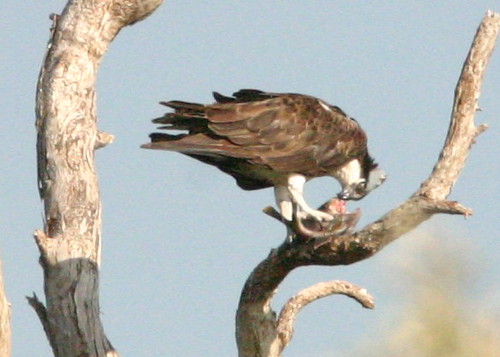An essential ingredient of Bald Eagles breeding habitat is the presence of suitable roost trees within sight of the nest. Our local pair of eagles is no exception, and they favor three or four tall Australian Pines along Pines Boulevard, as well as the trunks of melaleuca trees in the SW Florida Water Management District land just to the west of the proposed City of Pembroke Pines Bald Eagle sanctuary. In an effort to restore the wetlands to a more normal “Everglades,” these exotic trees were all intentionally killed by herbicides a few years ago. They are badly decayed and many fall down with each windstorm. As these roosting sites disappear, we can expect the eagles to seek out other prominent perches, such as power poles. Electrocution and collision with power lines are major causes of urban Bald Eagle mortality.
On June 11, Bald Eagle Sanctuary Steering Committee members Barry Heimlich of South Florida Audubon, and veteran eagle watcher Trisha Norton met at the site of the Pembroke Pines nest with Doug Macke, Florida Power & Light Company Broward Area Power Systems Environmental Coordinator, to discuss this hazard. They were pleased to learn that Doug had been observing the eagles since last year, when the nest was first “discovered,” and the company had already taken some action.
The FPL transmission lines run along the south side of Pines Boulevard, about 150 feet in front of the nest tree. The nest site is opposite the white truck parked on the roadside, and one of the eagles’ favorite roosting trees rises prominently in the foreground, above the wires:
Even before concerns were raised by eagle watchers about the proximity of FPL power lines to the nest, Doug had acted to reduce the danger to the birds. Raptor guards were placed at the tops of several poles. These insulated sleeves extend along the top wire, about 3 feet in each direction, to provide some protection against electrocution of large birds that may perch atop the poles. Additional insulation was added to the wires that extend down along the poles:
To increase visibility of the wires and reduce the chance of collision, Doug had bright yellow “curly-cues” installed at intervals along the top three wires:
Some power poles, such as this one, that run along the stand of dead roosting trees are yet to be fitted with protective devices:
The Bald Eagle Steering Committee also expressed concern about the possible loss of the roost trees that were nearer to the power lines. FP&L must trim certain branches that may damage the lines and interrupt service during hurricanes. Recognizing that FP&L does have such a responsibility, the Committee members asked, if pruning of the roost trees is necessary, that FP&L might consider selective “directional pruning” rather than removal.
After examining the roost trees that were identified by Trisha, Doug believed that none of them presently posed any danger to the lines:
According to Trisha’s account of the meeting, “[Doug] explained that the routine trimming occurs in 3 yr cycles and he is going to find out and send us the date of the last trim so we can anticipate the next trimming. He said that when this happens, our input would be welcomed. He also said we would be contacted when it is to be done. He said, in answer to one of your concerns, that FPL does not do the trimming themselves, but hires a tree company, so he felt it very important that we have representation before and during the work.” Doug was also aware that unnecessary disturbances would be avoided during the eagles’ nesting season.

Osprey in flight:
In recent weeks, at least eight Ospreys have died along a relatively small stretch of the Florida Gulf coast in Pinellas County near Clearwater. Food for the young appeared to be adequate this spring. According to Barbara Walker, OspreyWatch Program Coordinator from Palm Harbor, these birds have generally done very well. In her estimation, fledglings have been produced in 90% of approximately 30 Osprey nests she has been observing, all in heavily populated areas. Osprey watchers have counted 140 nests in the northern part of the county, of which 90% were on man-made structures such as power poles, cell towers and nest platforms.
Barbara writes: “As far as we know they were all severely emaciated. Some of the locations include Pasadena, Clearwater, Dunedin, and Tarpon Springs. In one instance, on the same property, two Osprey and 1 yard cat perished. The Fish and Wildlife Commission has been contacted in hopes that they will investigate. If anyone can share recent Osprey observations or photographs or has first hand information about a sick or dead Osprey please contact [Barbara] or call 727-431-2856.”
“I think there is something wrong ecologically or environmentally here.One theory was that the water temperature could be too hot and the fish are too deep. Climate change? However I would think the recent rains would have cooled the water somewhat. Anyway, we can’t help but wonder why so many deaths in such a short period of time and I am raising a red flag in this area.”
Most of the dead Ospreys were juveniles. One had been observed catching fish and visiting the nest shortly before its death, and a neighborhood cat also died mysteriously, raising suspicion that some sort of toxicity was involved. Barbara stated that one theory is that as juveniles “they were not highly skilled and were unable to catch any fish in the heavy rains.” However, she noted that the timing of the death of this particular bird “does not coincide with the other recoveries. All of these Osprey are along a specific area of the coast. We have not yet had any reports of Osprey down among other more inland groups such as the Lake Tarpon group or the North Tampa Bay Derby Lanes group to my knowledge although I am sure that more juveniles were treated at Suncoast Seabird Sanctuary that may have come from those areas or areas to the south.”
Barbara related that the Florida Fish and Wildlife Conservation Commission (FWC) is coordinating necropsies for several of the Osprey. “One was done this week. We will have to wait for the results. Comments from rescuers have consistently been that these are the most emaciated Osprey they have seen, just feathers and bone.”
Since ospreys share the top of the fish-eating predator food chain with Bald Eagles and many other herons, gulls and terns, I find this issue, so well described by Barbara, to be a major concern. Perhaps there are particular risks along a small strip of the Pinellas County coastline. We hope the cause of the deaths is determined.
We will be following this issue on our local Pembroke Pines Bald Eagle Watchers FORUM
Here is Barbara Walker’s map, showing the locations of the Osprey deaths:














